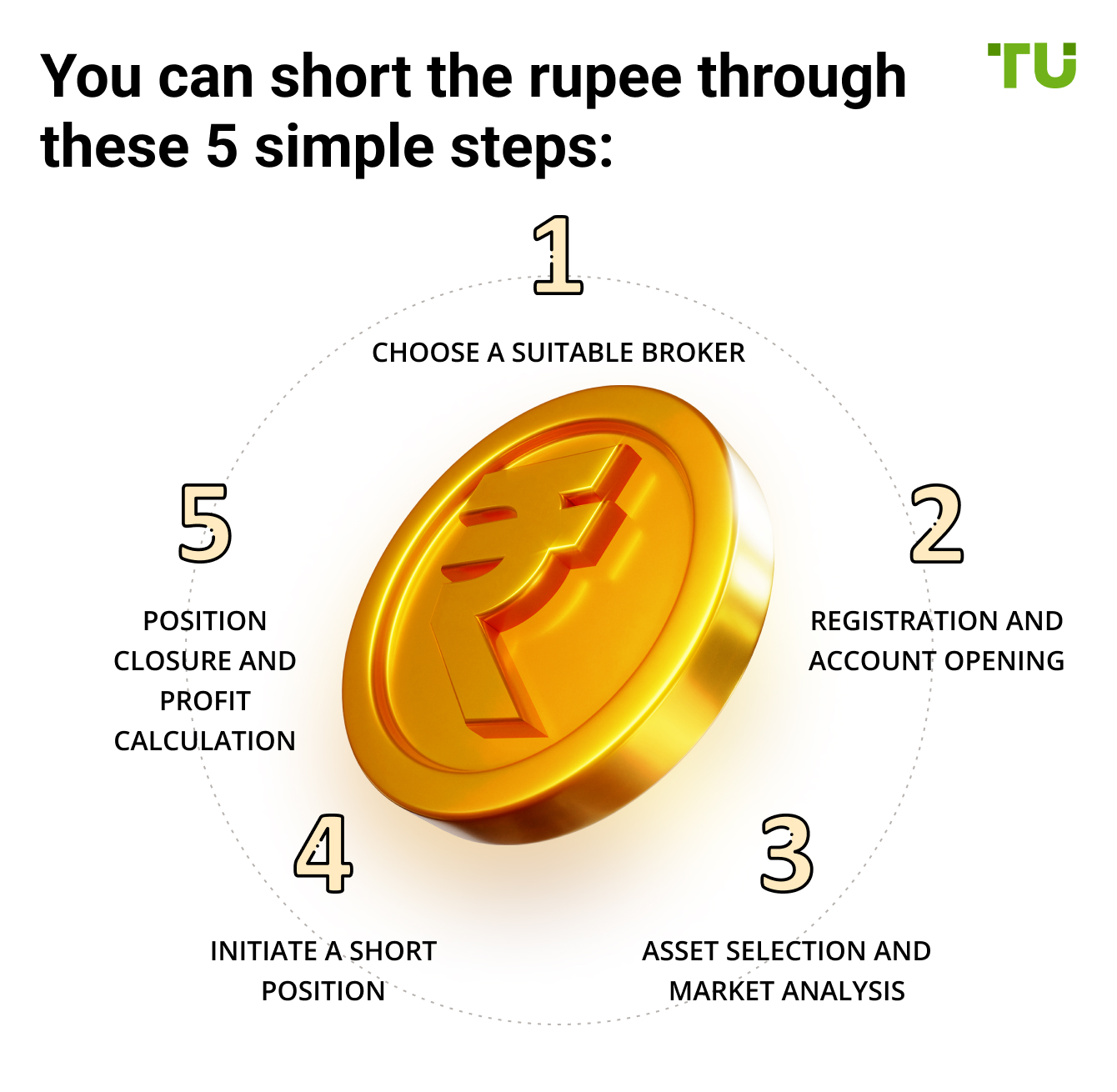The Best Brokers For Shorting The Rupee



Editorial Note: While we adhere to strict Editorial Integrity, this post may contain references to products from our partners. Here's an explanation for How We Make Money. None of the data and information on this webpage constitutes investment advice according to our Disclaimer.
If you're too busy to read the entire article and want a quick answer, If you are too busy to read the entire article and want a quick answer, the best broker to short a rupee is Plus500. Why? Here are its key advantages:
- Is legit in your country (Identified as United States
)
- Has a good user satisfaction score
- Educational materials for both beginners and experienced traders
- Low fees associated with transactions
Best rupee brokers:
- Eightcap - Best broker to trade directly from TradingView charts
- XM Group - Best Order Execution (99.35% of orders are executed nearly instantly)
- RoboForex - Best Forex broker for beginners ($10 min. deposit, copy trading)
- Exness - Best raw spread account (avg. spread for major FX pairs 0.1-0.2 pips)
- VT Markets - Attractive Forex bonuses (50% welcome bonus, 20% deposit bonus)
Most people know you can make money by buying a currency and selling it when its value increases, called a long position. However, you can also profit when an asset's value decreases through a short position.
This applies to various assets, including currencies and stocks. While shorting can be risky, it has the potential for high returns.
In this article, we offer a step-by-step guide on shorting the Rupee, explain how the Indian currency markets operate, and discuss Forex regulation in India.
Best Brokers to short Rupee
We advise you to check out our comparison table to choose the broker for shorting Rupee:
| Eightcap | XM Group | RoboForex | Exness | VT Markets | |
|---|---|---|---|---|---|
|
Min. deposit, $ |
100 | 5 | 10 | 10 | 100 |
|
Trading features |
Free 30-day demo account; Account types with standard and raw spreads; Minimum deposit is $100; Over 800 assets in the pool; High leverage; High-quality training; A lot of current analytics; Special tools for technical and fundamental analyses |
There are Islamic accounts; It is possible to connect to the MQL5 trading services. | Negative Balance Protection; No swaps on Islamic accounts, a pleasant affiliate program: each market participant gets up to 20% loyalty; One Click Trading. | Floating spreads; Fixed fee per lot on professional account types. |
No cryptocurrencies are among the assets available for trading |
|
Currency pairs, number of pairs |
40 | 57 | 40 | 100 | 55 |
|
Accounts |
Standard, raw, demo | Ultra Low, Zero | ProCent, Pro, ECN, Prime, R StocksTrader | Standard type: Cent, Standard, and Plus Professional type: Pro, Zero, and Raw Spread |
Demo МТ4, Demo МТ5, Standard STP account, RAW ECN account, Islamicaccounts (STP and ECN) |
|
Allowed in India |
Yes | Yes | Yes | Yes | Yes |
|
Base account currency (INR) |
No | No | No | No | No |
|
Open account |
Open an account Your capital is at risk. |
Open an account Your capital is at risk. |
Open an account Your capital is at risk. |
Open an account Your capital is at risk.
|
Open an account Your capital is at risk. |

Choose a suitable broker for you
To start, choose a broker with favorable trading conditions, low minimum deposit requirements, and low transaction fees. The choice of your broker must be in line with the requirements of your trading strategy.Registration and sign in
After selecting a suitable broker, register and open an account. You might consider registering through top platforms reviewed by organizations like TU, as this could provide rebates on trading fees, making your trading more cost-effective.Asset selection and market analysis
With your account set up, choose a rupee pair to trade and analyze market conditions. Use both technical and fundamental analysis to understand the market and predict potential price movements.Initiate a short position
You'll take a short position on the Indian Rupee by borrowing Rupees from your broker and selling them. When the price drops to your target, buy back the Rupees to close the position.Position closure and profit calculation
The final step is closing the position by repurchasing the Rupees you borrowed. The broker will receive the borrowed funds and any fees. Your profit is the difference between the selling price and the repurchase price.
What does a short position mean?
Many traders use short positions on Forex. Here's a simple example using stocks to explain how it works.
Suppose a trader believes IBM stock will drop by the evening. He borrows 100 IBM shares from his broker and sells them at $150 each. Later, when the price drops to $120, he buys back the shares and returns them to the broker.
Here's the profit calculation:
Sold shares: 100 x $150 = $15,000
Bought shares: 100 x $120 = $12,000
Profit: $15,000 - $12,000 = $3,000 (minus trading fees)
This same principle applies to short positions on currencies, where you sell borrowed funds and buy them back at a lower price to return to the broker.
Sell order in the Forex market
Shorting in Forex is simpler than in the stock market, as you don't need to borrow the currency. You just place a sell order.
In Forex, currency pairs consist of a base currency and a quote currency (e.g., XYZ/ABC, where XYZ is the base and ABC is the quote). Price changes are measured in pips, which is 0.0001 of the quoted currency's value, except for JPY pairs where a pip is 0.01.
Trades are usually made in standard lots (100,000 units of the base currency), but can also be in mini lots (10,000 units) or micro lots (1,000 units).
For example, if XYZ/ABC is at 2.3456, selling this pair means you expect XYZ to drop in value. If the rate drops to 2.3443, you gain 13 pips. To calculate the pip value for a standard lot, use this formula:
0.0001 (one pip) / 2.3456 (exchange rate) x 100,000 (lot size) = $4.26 per pip $4.26 x 13 = $55.38
So, 13 pips would result in a $55.38 gain, excluding commissions.
What affects Rupee trading
Several factors influence the INR's movement against other currencies, including both global and domestic elements.
Global factors
USD index: this index measures the dollar's strength and significantly affects the INR. Changes in the index impact the rupee's value;
Global developments: international events, like changes in Federal Reserve policies, can influence the INR;
Trade deficit and capital outflows: a growing trade deficit or significant capital outflows can weaken the rupee;
Central bank interventions: the Reserve Bank of India's actions in the global market help stabilize the INR.
Domestic factors
Inflation: higher inflation reduces the rupee's purchasing power, potentially weakening it;
Interest rates: higher real interest rates can strengthen the rupee by making it more attractive to investors;
Fiscal deficit: keeping the fiscal deficit around 3% of GDP supports the rupee's stability;
Government intervention: government policies, though less influential than before, still impact the rupee.
Trading strategies
Speculative strategy: shorting the INR can be a speculative move based on technical analysis. Look for price signals, such as a recent high followed by a downward trend, to determine the right time to short;
Hedging: investors may short the INR to hedge against potential losses if they hold assets in other appreciating currencies, like Euros or British pounds. This strategy helps protect against unfavorable exchange rate changes.
Is Forex trading legal in India?
Forex trading in India is regulated by the Reserve Bank of India (RBI), which imposes certain restrictions . According to the Foreign Exchange Management Act (FEMA), most forms of Forex trading are illegal. However, trading is allowed for specific currency pairs involving the Indian Rupee (INR) such as EUR/INR, GBP/INR, JPY/INR, and USD/INR, along with major pairs like EUR/USD, GBP/USD, and USD/JPY.
These trades can only be conducted through the National Stock Exchange (NSE), the Bombay Stock Exchange (BSE), and the Metropolitan Stock Exchange (MSE), and must be done via licensed Indian brokers.
The RBI enforces these rules to protect the stability of the INR. If Indian traders incur losses in foreign currency trading, they might need to buy USD from the RBI, which could lead to USD outflows and devalue the INR. Traders can choose a broker that is regulated by a local regulator or another reputable international regulator.
| ASIC | FCA | SEC | CNMV | CySec | BaFin | Open account | |
|---|---|---|---|---|---|---|---|
| Yes | Yes | No | No | Yes | No | Open an account Your capital is at risk. |
|
| No | No | No | No | Yes | No | Open an account Your capital is at risk. |
|
| No | No | No | No | No | No | Open an account Your capital is at risk. |
|
| No | Yes | No | No | Yes | No | Open an account Your capital is at risk.
|
|
| Yes | No | No | No | No | No | Open an account Your capital is at risk. |
Is Forex trading taxable in India?
Yes, Forex traders in India are subject to taxation. Traders in India are subject to two primary types of taxes: direct and indirect:
Direct taxes include a 5%-30% income tax;
Capital gains tax is 15% for short-term profits and 10% for long-term ones.
Trading income under 2.5 lakhs of Indian rupees is not taxable.
Analyze and achieve success
In my experience, the best brokers for shorting the Rupee offer a combination of low transaction costs, reliable execution, and advanced trading tools.
These brokers provide the necessary liquidity and market analysis features that allow me to make informed decisions quickly. Their platforms are robust, ensuring trades are executed efficiently, which is crucial when shorting a volatile currency like the Rupee.
The ability to access comprehensive risk management tools also plays a significant role in managing potential losses effectively.
Our Methodology
Traders Union applies a rigorous methodology to evaluate brokers using over 100 both quantitative and qualitative criteria. Multiple parameters are given individual scores that feed into an overall rating.
Key aspects of the assessment include:
Regulation and safety. Brokers are evaluated based on the level/reputation of licenses and regulations they operate under.
User reviews. Client reviews and feedback are analyzed to determine customer satisfaction levels. Reviews are fact-checked and verified.
Trading instruments. Brokers are evaluated on the breadth and depth of assets/markets available to trade.
Fees and commissions. A comprehensive analysis is done of all trading costs to analyze overall cost to clients.
Trading platforms. Brokers are assessed based on the variety, quality and features of platforms offered to clients.
Other factors like brand popularity, customer support, education resources are also evaluated.
Summary
The best brokers for shorting the Rupee should be selected focusing on key factors like legitimacy, user satisfaction, educational resources, and low fees.
Shorting the Indian Rupee includes steps such as choosing a broker, registering an account, analyzing the market, initiating a short position, and calculating profits.
Particularly in Forex, the process of shorting is simpler, calling for only placing a sell order. The factors that influence the value of the INR include such as global and domestic conditions and traders can use strategies like speculative moves and hedging to do the same.
FAQs
How do I short the currency?
To short currency, you sell a currency pair, aiming to profit from its decline in value. You buy it back at a lower rate to complete the trade.
Can you short a national currency?
Yes, you can short a national currency by trading currency pairs that involve that currency, anticipating its decrease in value.
What does it mean to go short on a currency position?
Going short on a currency position means selling a currency pair with the expectation that the base currency will weaken against the quoted currency.
How to trade currency in India?
In India, trade currency through licensed brokers on authorized exchanges, adhering to legal currency pairs and regulations set by the Reserve Bank of India.
Related Articles
Team that worked on the article
Mikhail Vnuchkov joined Traders Union as an author in 2020. He began his professional career as a journalist-observer at a small online financial publication, where he covered global economic events and discussed their impact on the segment of financial investment, including investor income. With five years of experience in finance, Mikhail joined Traders Union team, where he is in charge of forming the pool of latest news for traders, who trade stocks, cryptocurrencies, Forex instruments and fixed income.

Dr. BJ Johnson is a PhD in English Language and an editor with over 15 years of experience. He earned his degree in English Language in the U.S and the UK. In 2020, Dr. Johnson joined the Traders Union team. Since then, he has created over 100 exclusive articles and edited over 300 articles of other authors.
Mirjan Hipolito is a journalist and news editor at Traders Union. She is an expert crypto writer with five years of experience in the financial markets. Her specialties are daily market news, price predictions, and Initial Coin Offerings (ICO).






























































































































